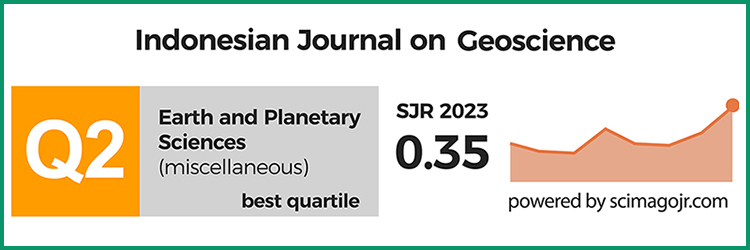Waduk Parangjoho dan Songputri: Alternatif Sumber Erupsi Formasi Semilir di daerah Eromoko, Kabupaten Wonogiri, Jawa Tengah
DOI:
https://doi.org/10.17014/ijog.4.2.77-92Keywords:
Parangjoho, Songputri, Dams, Semilir Formation, co-ignimbrite breccia, volcanic block and bom, pumiceAbstract
https://dx.doi.org/10.17014/ijog.vol4no2.20091
The Semilir Formation was typically originated from products of a very explosive volcanic activity, i.e. breccias, lapillistones, and tuffs containing abundant pumice. It has a light grey to white colour and high silica andesite to dacite in composition, mainly rich in volcanic glass and quartz. Sedimentary structures of these volcanic rocks are massive, grading, planar bedding, and cross-bedding to antidunes, with grain size varies from ash (≤ 2 mm) to lapilli (2 – 64 mm) to bomb and block (> 64 mm). The formation is widely distributed from the west side (Pleret and Piyungan areas, Bantul Regency, Special Province of Yogyakarta) until Eromoko area in the east (Wonogiri Regency, Jawa Tengah Province). Stratigraphically, the Semilir Formation underlies the Nglanggeran Formation, and overlies the Mandalika Formation in the eastern part and Kebo-Butak Formation in the western part.
Geomorphological- and lithological analyses of the Semilir Formation in areas of Parangjoho and Song- putri Dams, Eromoko Sub-regency, Wonogiri Regency indicate that the two depressions were alternatively volcanic sources of the Semilir Formation in the Eromoko area. This is proved by the presence of co-ignimbrite breccias(co-ignimbrite lag fall deposits), that descriptively they are polymict breccias. This rock is characterized by a mixing of pumice and various hard rock fragments that primarily are juvenile materials (volcanic blocks, bombs), accessory-, and accidental rock fragments set in pumice-rich volcanic ash and lapilli sizes. The accessory materials came from older volcanic rocks, whereas the accidental ones were originated from basement rocks.
During a caldera forming event or a destruction period of an older composite volcanic cone(s), all older rocks resting above the magma chamber were ejected to the surface by a very high magmatic pressure. Since they were heavier than the juvenile material, most accessory and accidental rock fragments were left (lag fall) in caldera rim behind the ash and pumice flow. In the dam areas of Parangjoho and Songputri, the lag fall fragments consisting of andesite, pyroxene andesite, dacite, and pumice, being 10 – 150 cm in diameter are set in pumice-rich lapilli tuffs. Some of the rock fragments are volcanic blocks and bombs, while the older rocks are angular to very angular shape, having prismatic jointing or jigsaw-crack structures. The eruptions in the Parangjoho and Songputri craters were controlled by north-south trending fractures, and they resemble to the Katmaian caldera explosion type.
References
Anonim, 1976. Laporan penyelidikan geologi teknik Bukit Kiri rencana waduk serba guna Wonogiri. Bagian Teknik Geologi, FT-UGM, Yogyakarta. 14 h. (tidak terbit).
Braney, M.J., Kokelaar, P., dan Kokelaar, B.P., 2002. Pyroclastic density currents and sedimentation of ignimbrites. Geological Society, Memoir, 27, 156 p.
Bronto, S., 2006. Fasies gunung api dan aplikasinya. Jurnal Geologi Indonesia, 2 (1), h. 59-71.
Bronto, S., 2008. Fosil gunung api di Pegunungan Selatan Jawa Tengah. Publikasi khusus Jurnal Geologi dan Sumber Daya Mineral, PSG, hasil Seminar dan Workshop “Potensi Geologi Pegunungan Selatan dalam Pengembangan Wilayah”. Kerjasama PSG, UGM, UPN “Veteran”, STTNAS dan ISTA, Yogyakarta, 27-29 Nov. 2007, (in press)
Cas, R.A.F. dan Wright, J.V., 1987. Volcanic successions: modern and ancient. Allen and Unwin, London, 528 h.
Fisher, R.V. dan Schmincke, H.U., 1984. Pyroclastic Rocks. Springer-Verlag, Berlin, 472 h.
Hartono, G., 2000. Studi gunung api Tersier: Sebaran pusat erupsi dan petrologi di Pegunungan Selatan, Yogyakarta. Tesis magister, Program Studi Teknik Geologi, Program Pasca Sarjana, ITB, Bandung, 168 h, (tidak terbit).
Hartono, G., 2007. Studi batuan gunung api pumis: Mengungkap asal mula Bregada gunung api purba di Pegunungan Selatan, Yogyakarta. Publikasi khusus Jurnal Geologi dan Sumber Daya Mineral, PSG, hasil Seminar dan Workshop “Potensi Geologi Pegunungan Selatan dalam Pengembangan Wilayah”. Kerjasama PSG, UGM, UPN “Veteran”, STTNAS dan ISTA, Yogyakarta, 27-29 Nov. 2007, (in press).
Kusumadinata, K., 1979. Data Dasar Gunung Api Indonesia. Direktorat Vulkanologi, Bandung, 820 h.
Macdonald, G.A., 1972. Volcanoes. Prentice-Hall, Englewood Cliffs, New Jersey, 510 h.
Martodjojo, S. dan Djuhaeni, 1996. Sandi Stratigrafi Indonesia. Komisi SSI – IAGI, Jakarta, 25 h.
Newhall, C.G. dan Self, S., 1982. The Volcanic Explosivity Index (VEI): an estimate of explosive magnitude for historical volcanism. Journal of Geophysical Research, 87, h.1231-38.
Rahardjo, W., Sukandarrumidi, dan Rosidi, H.M.D., 1977. Peta Geologi Lembar Yogyakarta, Jawa, skala 1: 100.000. Pusat Penelitian dan Pengembangan Geologi, Bandung.
Simkin, T. dan Fiske, R.S., 1983. Krakatau 1883: The volcanic eruption and its effects. Smithsonian Inst. Press., Washington D.C., 464 h.
Simkin, T. dan Siebert, L., 1994. Volcanoes of the World, 2nd Ed. Geoscience Press, Inc. In association with the Smithsonian Institute,Tucson, Arizona, 349 h.
Sudarno, I., 2007. Evolusi tegasan purba dan genesa sesar di daerah Pegunungan Selatan DIY dan sekitarnya. Publikasi khusus Jurnal Geologi dan Sumber Daya Mineral, PSG, hasil Seminar dan Workshop “Potensi Geologi Pegunungan Selatan dalam Pengembangan Wilayah”. Kerjasama PSG, UGM, UPN “Veteran”, STTNAS dan ISTA, Yogyakarta, 27-29 Nov. 2007, (in press).
Surono, Toha, B., dan Sudarno, I. 1992. Peta Geologi Lembar Surakarta, Jawa, skala 1: 100.000. Pusat Penelitian dan Pengembangan Geologi, Bandung.
Van Bemmelen, R.W., 1949. The Geology of Indonesia, Vol. IA. Martinus Nijnhoff, The Hague, 732 h.
Voight, B., Glicken, H., Janda, R.J., dan Douglass, P.M., 1983. Catastrophic rockslide-avalanche of May 18. Dalam: Lipman, P.W. & Mullineaux, D.R. (Eds.), The 1980 eruptions of Mount St. Helens. Washington, U.S. Geological Survey Professional Paper 1250, h. 347-348.
Walker, G.P.L., 1985. Origin of coarse lithic breccias near ignimbrite source vents. Journal of Geothermal and Volcanology Research, 25, h.157-171.
Williams, H. dan McBirney, A.R., 1979. Volcanology. Freeman, Cooper & Co., San Francisco, 398 h.
Wright, J.V., 1981. The Rio Caliente ignimbrite: analysis of a compound intraplinian ignimbrite from a major Late Quaternary
Mexican eruption. Bulletin of Volcanology, 44, h.189-212.
Wright, J.V. dan Walker, G.P.L., 1977. The ignimbrite source problem: significance of a co-ignimbrite lag-fall deposit. Geology, 5, h.729-732.



















